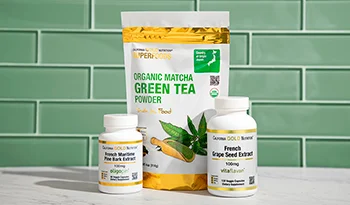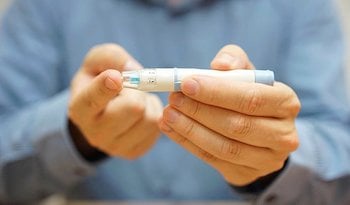氨基葡萄糖:它的益处、形态、关节健康等
免责声明:本博客不提供诊断⋯

什么是氨基葡萄糖?
氨基葡萄糖是由葡萄糖(血糖)和含氮胺分子在体内合成的一种天然化合物。在体内,氨基葡萄糖刺激糖胺聚糖(GAGs)的生成,而后者是软骨、肌腱和韧带中的结构支撑分子。
氨基葡萄糖能缓解炎性反应吗?
50多年前,世界卫生组织(WHO)进行了一项开创性的研究,发现随着年龄的增长,人体会失去制造足量氨基葡萄糖的能力。
没有足够的氨基葡萄糖,软骨就会失去其凝胶状性质和作为减震器的能力。糖胺聚糖(GAGs)是软骨的结构支架,对于维持软骨和其他关节成分的高含水量至关重要。如果没有足够的氨基葡萄糖,关节就会开始退化(无法正常工作)。氨基葡萄糖对炎性反应的过程也有一定作用。
在发现氨基葡萄糖与关节健康的联系后,深入的科学研究显示了补充氨基葡萄糖在支持关节健康方面的基本原理和作用。氨基葡萄糖被世界上许多地方的医学机构推荐为修复关节健康问题的优选方案。
氨基葡萄糖有什么作用?
对关节健康的益处
硫酸葡糖胺软骨素(GS)是氨基葡萄糖的特好形式,也是促进关节健康的主要膳食补充剂。大量人体双盲研究表明,GS能显著优化疼痛、关节功能指标和软骨健康的血液标志物。一般来说,使用2至4周后就能看到这些益处,但也有证据表明,使用GS的时间越长,关节健康的益处就越大。
两项时间极长的安慰剂对照试验持续了三年。这些研究结果令人信服地表明,GS减缓了因关节老化或机械应力引起的软骨损坏,X光片和医学评估结果都表明了这一点。研究结果还显示,在这些研究中服用GS的人,即使在停止服用长达5年后,其全关节置换的次数也明显减少。
预防损伤和修复
GS可以预防软骨退化,尤其适用于关节劳损的运动员,如跑步者或参与足球、橄榄球、篮球或其他负重运动的运动员。GS还有助于轻微急性关节扭伤和拉伤的修复。一项双盲研究显示,每天服用1,500或3,000毫克的GS,并持续服用3个月的足球运动员,其血液中软骨合成的标志物有所增加,而软骨分解的比率则有所下降,进而证明了它对软骨的保护作用。
氨基葡萄糖的食物来源
氨基葡萄糖没有食物来源。只能通过膳食补充剂的形式摄取。大多数市售的氨基葡萄糖来源于甲壳素——虾、龙虾和螃蟹的外骨骼。此外,还有一种由玉米微生物发酵产生的素食形式的氨基葡萄糖。
氨基葡萄糖的形式:哪种极好?
硫酸葡糖胺软骨素(GS)
硫酸葡糖胺软骨素(GS)已经过广泛研究,超过300项科学调查和30项双盲研究都强调指出其优效性。它是氨基葡萄糖的优选形式,已被全球数百万人广泛接受。
GS已在70多个国家被注册为关节健康辅助方方剂,证明了其上越的功效。
针对GS吸收和分布的人体研究显示,其吸收率高达98%,令人赞叹。一旦被吸收,它主要针对关节组织,促进软骨、韧带和肌腱的生成。这凸显了它在支持关节健康方面的关键作用。
盐酸氨基葡萄糖(GHCL)
由于硫酸氨基葡萄糖(GS)的主要作用之一是促进糖胺聚糖(GAGs)的制造,因此在使用盐酸葡糖胺软骨素(GHCL)时,硫的缺乏可能意味着糖胺聚糖合成的减少。
因此,由于缺乏这一关键元素,仅使用GHCL不太可能取得与GS同样出色的医学效果。
双盲研究结果表明,在促进关节健康方面,GHCL并没有比安慰剂更优效。一项双盲、安慰剂对照的人类研究检视了GHCL对受试者膝盖健康的影响。受试者服用了500毫克的GHCL或安慰剂,每天三次,持续10周。结果显示,两组之间的差异没有统计学意义。
在一项关于GHCL范围极广的研究中,1583例膝关节疼痛和关节功能不良的患者被随机分组,连续24周每天接受1500毫克GHCL、1200毫克硫酸软骨素、GHCL和硫酸软骨素(剂量与单臂实验组相同)、200毫克塞来昔布或安慰剂。结果显示,在研究开始时患有中度至重度疼痛的患者中,同时服用GHCL和硫酸软骨素的受试者的缓解率明显高于安慰剂组(79.2%对54.3%)。然而,与安慰剂相比,服用GHCL或硫酸软骨素的组没有获得任何益处。
N-乙酰葡糖胺(NAG)
N-乙酰葡糖胺(NAG)与硫酸氨基葡萄糖(GS)的不同之处在于,N-乙酰葡糖胺(NAG)没有连接硫分子,而是有一部分乙酸分子。因此,人体对GS和NAG的处理方式也不同。氨基葡萄糖容易被人体吸收,而NAG则不然。由于多种原因,人体对NAG的吸收率很低:
- NAG很快就会被肠道细菌消化。
- NAG在肠道中与食物中的凝集素结合,形成凝集素-NAG复合物随粪便排出体外。
- 很大一部分NAG会被肠道细胞代谢掉。
除了吸收问题外,关节组织也不能像氨基葡萄糖那样很好地利用NAG。这些吸收和利用问题表明,NAG不大可能像GS一样对关节健康有益。销售NAG的公司声称NAG是一种对关节健康更好的氨基葡萄糖,但科学数据并不支持这些说法。
剂量
GS的标准使用剂量为每天1500毫克,单次服用可能会产生更好的效果。此外,运动员或关节磨损较严重的人可能需要将剂量增加到3000毫克,以支持软骨健康。
副作用和安心性
硫酸氨基葡萄糖具有良好的安心性记录。研究认为,其副作用与安慰剂无异,非常罕见,一般只限于轻微的胃肠道刺激。
氨基葡萄糖和软骨素
人们经常将氨基葡萄糖与硫酸软骨素(CS)放在一起讨论。然而,根据大量的医学证据,只有硫酸氨基葡萄糖(GS)在作为独立制剂使用时,一直有数据证实其具有医学效能。大量研究表明,将盐酸氨基葡萄糖(GHCL)和硫酸软骨素(CS)结合使用是优效的,而单独使用GS则具有更显著的医学效能。
此外,研究还表明,将硫酸氨基葡萄糖(GS)与硫酸软骨素结合使用并不会比单独使用GS带来更大的益处。不过,当GS或GS+CS与甲磺酰基甲烷(MSM)结合使用时,可能会带来更多的益处。同样,将MSM与GHCL结合使用,可以通过供给必需的硫来加强GHCL的功效。
硫在GS的修效能果中起着至关重要的作用,替代硫可能会降低补充氨基葡萄糖的功效。这种营养物质对关节组织至关重要,因为它能稳定软骨、肌腱和韧带的结缔组织基质。此外,硫还有助于防止软骨退化。因此,在糖胺聚糖(GAGs)中保持足够的硫含量对于防止软骨退化至关重要。
要点
总之,有关硫酸氨基葡萄糖的广泛研究强调了它在支持关节健康方面的重要性,以及它在促进整体健康方面的重要作用。
参考资料:
- Henrotin Y, Mobasheri A, Marty M. Is there any scientific evidence for the use of glucosamine in the management of human osteoarthritis? Arthritis Res Ther. 2012 Jan 30;14(1):201.
- Herrero-Beaumont G, Largo R. Glucosamine and O-GlcNAcylation: a novel immunometabolic therapeutic target for OA and chronic, low-grade systemic inflammation? Ann Rheum Dis. 2020 Oct;79(10):1261-1263.
- Conrozier T, Lohse T. Glucosamine as a Treatment for Osteoarthritis: What If It's True? Front Pharmacol. 2022 Mar 17;13:820971.
- Knapik JJ, Pope R, Hoedebecke SS, et al. Effects of Oral Glucosamine Sulfate on Osteoarthritis-Related Pain and Joint-Space Changes: Systematic Review and Meta-Analysis. J Spec Oper Med. 2018 Winter;18(4):139-147.
- Bruyère O, Honvo G, Veronese N, et al. An updated algorithm recommendation for the management of knee osteoarthritis from the European Society for Clinical and Economic Aspects of Osteoporosis, Osteoarthritis and Musculoskeletal Diseases (ESCEO). Semin Arthritis Rheum. 2019 Dec;49(3):337-350.
- Knapik JJ, Pope R, Hoedebecke SS, Schram B, Orr R, Lieberman HR. Effects of Oral Glucosamine Sulfate on Osteoarthritis-Related Pain and Joint-Space Changes: Systematic Review and Meta-Analysis. J Spec Oper Med. 2018 Winter;18(4):139-147.
- Setnikar I, Palumbo R, Canali S, et al. Pharmacokinetics of glucosamine in man. Arzneimittelforschung 1993; 43:1109–1113.
- Zhu X, Sang L, Wu D, et al. Effectiveness and safety of glucosamine and chondroitin for the treatment of osteoarthritis: a meta-analysis of randomized controlled trials. J Orthop Surg Res. 2018 Jul 6;13(1):170.
- Meng Z, Liu J, Zhou N. Efficacy and safety of the combination of glucosamine and chondroitin for knee osteoarthritis: a systematic review and meta-analysis. Arch Orthop Trauma Surg. 2023 Jan;143(1):409-421.
- Simental-Mendía M, Sánchez-García A, Vilchez-Cavazos F, et al. Effect of glucosamine and chondroitin sulfate in symptomatic knee osteoarthritis: a systematic review and meta-analysis of randomized placebo-controlled trials. Rheumatol Int. 2018 Jun 11. doi: 10.1007/s00296-018-4077-2.
- Lubis AMT, Siagian C, Wonggokusuma E, Marsetyo AF, Setyohadi B. Comparison of Glucosamine-Chondroitin Sulfate with and without Methylsulfonylmethane in Grade I-II Knee Osteoarthritis: A Double Blind Randomized Controlled Trial. Acta Med Indones. 2017 Apr;49(2):105-111.
- Nunes RM, Girão VCC, Cunha PLR, et al. Decreased Sulfate Content and Zeta Potential Distinguish Glycosaminoglycans of the Extracellular Matrix of Osteoarthritis Cartilage. Front Med (Lausanne). 2021 Apr 29;8:612370.
- Houpt J.B, McMillan R, Wein C, et al. Effect of glucosamine hydrochloride in the treatment of pain of osteoarthritis of the knee. J Rheumatol 1999;26:2423–2430.
- Sawitzke A.D, Shi H, Finco M.F, et al. The effect of glucosamine and/or chondroitin sulfate on the progression of knee osteoarthritis: a report from the glucosamine/chondroitin arthritis intervention trial. Arthritis Rheum 2008;58:3183–3191.
- Sawitzke A.D, Shi H, Finco M.F, et al. Clinical efficacy and safety of glucosamine, chondroitin sulphate, their combination, celecoxib or placebo taken to treat osteoarthritis of the knee: 2-year results from GAIT. Ann Rheum Dis 2010;69:1459–1464.
- Capps JC, Shetlar MR, Bradford RH. Hexosamine metabolism. I. The absorption and metabolism, in vivo, of orally administered D-glucosamine and N-acetyl-D-glucosamine in the rat. Biochim Biophys Acta 1966;127194–204.
- Tesoriere G, Dones F, Magistro; et al. Intestinal absorption of glucosamine and N-acetylglucosamine. Experientia 1972;28 770–771.
- Bruyere O, Pavelka K, Rovati LC, et al. Glucosamine sulfate reduces osteoarthritis progression in postmenopausal women with knee osteoarthritis: evidence from two 3-year studies. Menopause 2004;11:138–143.
- Reginster JY, Deroisy R, Rovati LC, et al. Long-term effects of glucosamine sulphate on osteoarthritis progression: a randomised, placebo-controlled clinical trial. Lancet 2001;357:251–256.
- Pavelka K, Gatterova J, Olejarova M, et al. Glucosamine sulfate use and delay of progression of knee osteoarthritis: a 3-year, randomized, placebo-controlled, double-blind study. Arch Intern Med 2002;162:2113–2123.
- Bruyere O, Pavelka K, Rovati LC, et al. Total joint replacement after glucosamine sulphate treatment in knee osteoarthritis: results of a mean 8-year observation of patients from two previous 3-year, randomised, placebo-controlled trials. Osteoarthritis Cartilage 2008;16;254–260.
- Bruyere O, Honore A, Ethgen O, et al. Correlation between radiographic severity of knee osteoarthritis and future disease progression. Results from a 3-year prospective, placebo-controlled study evaluating the effect of glucosamine sulfate.、Osteoarthritis Cartilage 2003;1:1–5.
- Nagaoka I, Tsuruta A, Yoshimura M. Chondroprotective action of glucosamine, a chitosan monomer, on the joint health of athletes. Int J Biol Macromol. 2019 Jul 1;132:795-800.
- Yoshimura M, Sakamoto K, Tsuruta A, et al. Evaluation of the effect of glucosamine administration on biomarkers for cartilage and bone metabolism in soccer players. Int J Mol Med 2009;24:487–494.

 作者 迈克尔·默里(Michael Murray)博士,自然疗法医师
作者 迈克尔·默里(Michael Murray)博士,自然疗法医师 


